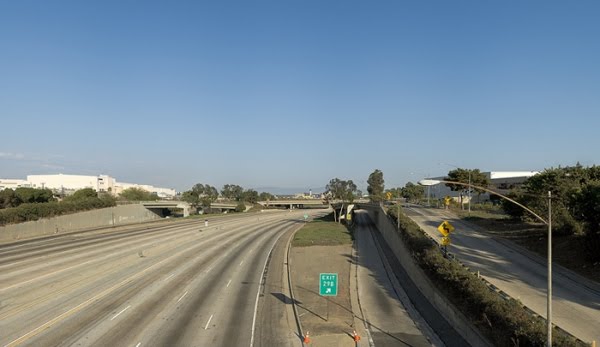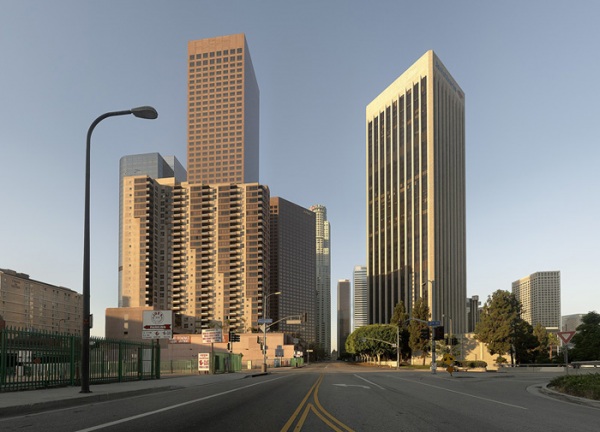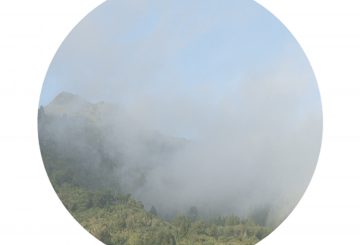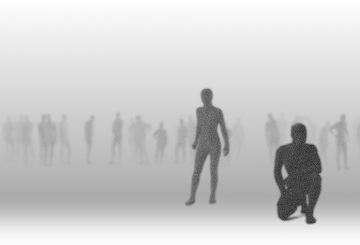Matt Logue is a Los Angeles based artist, photographer and animator. After working for the Tippett Studio – and spending three years in New Zealand on the Lord of The Rings trilogy – he returned to the US to pursue more personal work. Logue’s Empty LA project is a stunning visualisation of a world emptied of people.
The Art Life: In your Empty LA series you’re presenting a vision of a city that could never be fully experienced. What was your inspiration for the series?
Matt Logue: The inspiration for the series came, perhaps predictably, while on the freeway, driving to work. The thoughts that kept coming back was, “How did we get here? Why did we do it like this?” From there, I imagined an empty city, the sounds you would hear in the skyscraper canyons, the animals returning to make their homes in the shelters we’d built. After that, I simply had to see it, I couldn’t not do it, so after working out a technique to do it through trial and error, spend most of my free time for the past four years working on the images.
TAL: Empty cities, ruins and vacant spaces seem very much in vogue at the moment, what with all the post apocalyptic movies and books like ‘The World Without Us’ – yet they also recall a Romantic vision of the Sublime landscape. What do you suppose the viewer feels when they look at these contemporary images?
ML: By far the most common response I’ve gotten from people is “That is so creepy/spooky/unsettling,” followed by “I wish I could experience that.” While seeing each image gradually emerge, I would experience a surprisingly intense feeling of what I can only describe as relief, finally getting to see the empty freeways and downtown. My favorite images from other artists always leave me making up stories in my head or asking questions about the work – not necessarily about the technique, but about the relationships depicted, the evolution of civilization that led to a particular image. The art that keeps me coming back leaves some room for the viewer to participate in it, and I think people feel that with these images. They’re visually striking and I think they also strike an emotional chord with people, especially citizens of L.A.
TAL: How do you see your Empty LA work sitting with your other landscape work? The juxtaposition between natural landscapes and the artifice of the empty city work is startling.
ML: Empty LA was a departure from my other landscape work. For me, taking photos for the sole purpose of making a beautiful image is becoming more and more difficult – I keep wanting to place my images in the context of humanity and where we’re going or what our possible futures are. Lately I feel like making straight landscape images is like eating dessert three meals of the day – it can be fun, but becomes less and less fulfilling. Which is not to say that I don’t admire landscape photographers, far from it, but I think I trend more towards the school of thought of people like Richard Misrach and Robert Polidori, who make some absolutely stunning images while framing them in the context of the built world rather than just the strictly natural world. The other way Empty LA was different was that I had a relatively narrow project to work on and could really narrow down my thinking – my landscape work has been mainly done during stolen time when I’m travelling with my family or riding my bike around LA.
TAL: What did you do with Tippett and Lord of The Rings? Did that experience cross over into your photography work?
ML: I started at Tippett as a kind of low-level technician, making mattes for the compositors. I actually applied as an animator, so I came in early every day and worked like a dog to get into the animation department, which finally happened after about a year there. I animated on a few shows and then my wife and I moved to New Zealand, where I was an animator on all three Lord of the Rings films. While working as an animator, we frequently have to make the best of poorly-shot background plates, while making pleasing compositions. I think that daily practice in composition really helps me in my photography, and my photography in turn helps my animation – because I know a lot about traditional and digital photography, I’ve often been called on to do jobs outside of animation at the companies I work for.
TAL: The Empty LA images suggest a post apocalyptic scenario, a sci-fi narrative of some sort, yet at the same time there’s something oddly calming about them. Is there an element of wish fulfillment or fantasy in the images?
ML: The post-apocalyptic scenario is something I thought about a lot while working on it, but I left it intentionally vague – I didn’t want it to be too much of a narrative. This goes back to that “leaving space for the viewer” idea – I purposefully didn’t go into why or how humans had disappeared, only that they didn’t exist in this world anymore. Now what? What would happen to the city? For me, and for many other people, it’s very calming to imagine the planet continuing without us – the sun rises and sets, rain falls, animals live and die, all without our intervention. I, probably like many people, would be very interested to see how the world would develop in our absence. Many people have told me they wish they could experience that, to walk the highways from the sea into downtown, but what most interests me is imagining how the planet itself would develop without us. I don’t want to read too much into people’s responses, but I believe there’s another angle to this as well, given the current situation we’re in with the climate and environment. I think there’s an underlying sense of hopelessness in many people about what we as a species have done and are doing to the planet, and underneath that, a feeling of guilt. We’re so entrenched in our way of life that it feels impossible to do what needs to be done in time to keep massive climate change from happening, and seeing the world emptied of people, if only for a few minutes in a series of photographs, gives us a respite from that.
TAL: Absence is very powerful – your removal of people, cars, aircraft also takes away the point of identification most viewers would have when looking at images of a city. In some ways these images are almost like those classical images of natural landscapes by Ansel Adams. Was that a part of your thinking?
ML: I purposefully decided on a more formal approach to this series, to try and stay as anonymous as possible in my viewpoint. I even went so far as to not caption or identify the images – aside from the copyright information and the title page, there’s no text in the book. It’s a way of treating the city that’s been built up over the years as a natural landscape, because in the absence of humans, that’s exactly what it would be. Freeways might become migration routes, office buildings might be enormous bird habitats, and so on. The formal aspect of it also provides a framework for people to hang their own narratives and questions on, as opposed to me dictating people’s individual experiences of the images.
TAL: Without wanting to lift the veil too much on your process, could you tell us a little about the way the images were made? They seem, online at least, to almost seemless – was that the effect you wanted to achieve?
ML: Well, sadly it was never much of a veil – most of the images could only have been done digitally! It’s a curious situation – when people first see it, one of the first questions they ask is, “How did you do it?” To be completely honest, discussing my own techniques quickly becomes tiresome, as people ask what lenses or cameras I used, or what version of Photoshop, etc. Of course, I’d love to know that stuff about other photographers’ work, so I suppose I’m a bit of a hypocrite. The seamless effect was something I was going for, I wanted it to look and feel as natural as possible. In a nutshell, they’re mosaics of anywhere from thirty to well over one hundred images, all taken as close as possible to each other in time, and hand-blended in such a way as to remove the cars and people. I had to work backward from the framing and final print size I wanted and reverse-engineer how and when I was going to take the pictures. Google Street View helped immensely in scouting locations, usually overpasses and pedestrian walkways that didn’t have high protective barriers.
Matt Logue’s Empty LA can be purchased from Blurb.com Originally posted by our sister-blog Science Fictional





